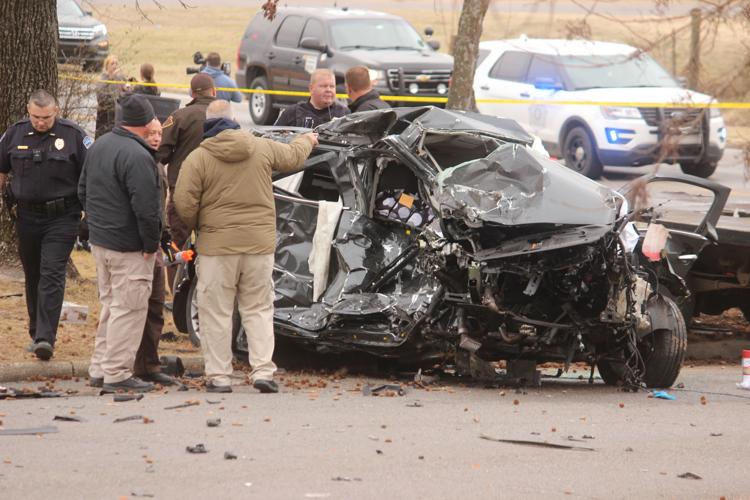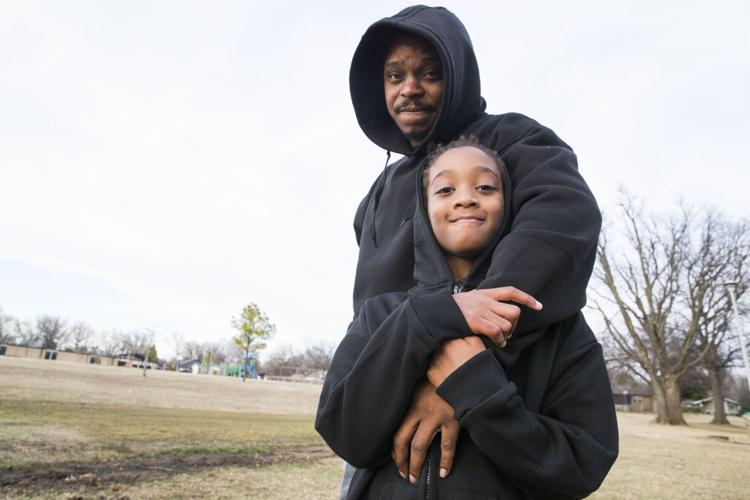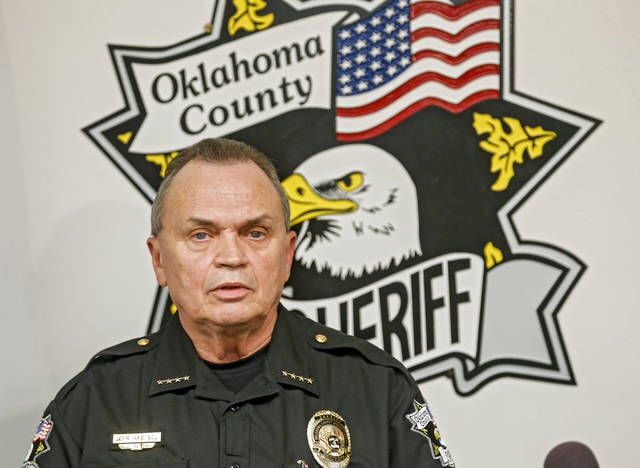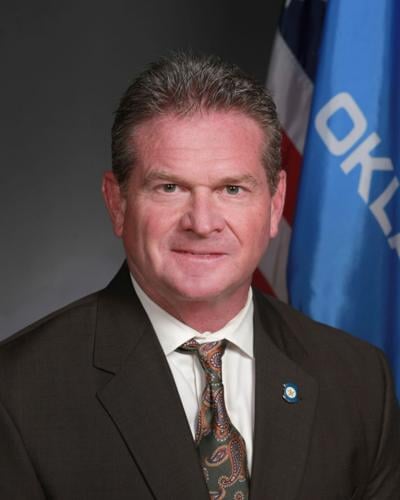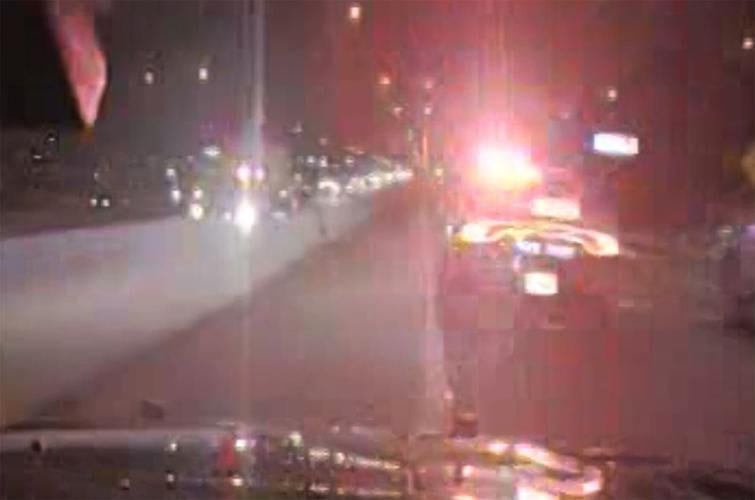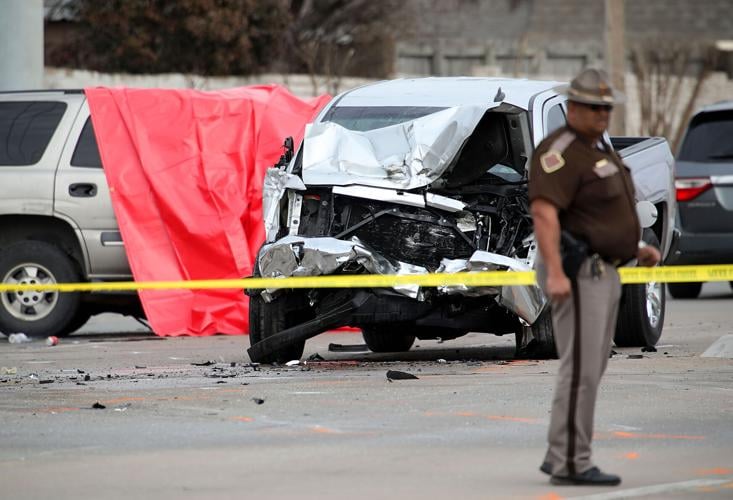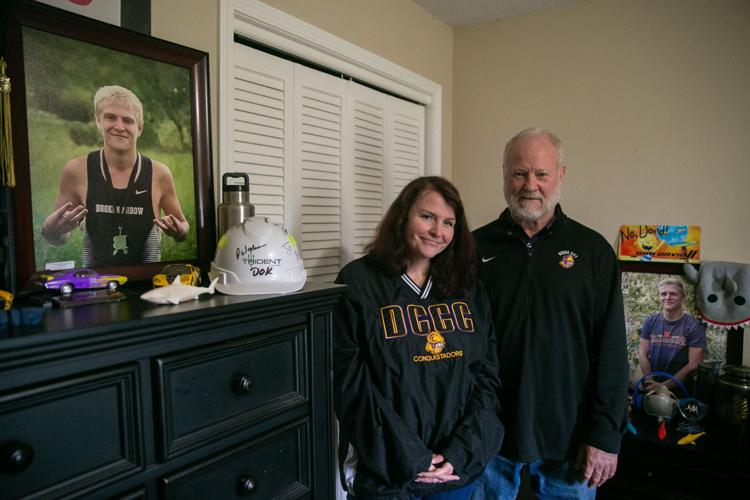A grandmother on her usual morning drive to church. A wife and mother called in for jury duty. A mother and her daughter running mid-day errands. A husband and father during his normal morning commute. A pregnant mother and her unborn child returning home after dropping off her two young sons at school.
People are also reading…
About one out of every four people killed in Oklahoma law enforcement car chases were innocent people not involved in the pursuits, according to a Tulsa World and Lee Enterprises Public Service Journalism investigation.
About two out of every five of the pursuit deaths weren’t even the drivers trying to elude law enforcement.
They were innocent motorists or passengers who were riding inside of fleeing vehicles.
One was an Oklahoma Highway Patrol lieutenant who was struck on foot by one of two troopers colliding at their own roadblock while chasing someone for traffic infractions.
Broadly, the vast majority of 68 fatal chases that killed 79 people from 2016 to 2022 were prompted by traffic violations or property crimes. Those reasons aren’t considered worth pursuing by many leading experts — and certainly not worth the loss of human life.
Oklahoma ranks 8th highest in the U.S. for pursuit-related deaths in the seven-year span examined, according to a World and Lee analysis of the latest federal traffic crash data available.
Some discussions among members of the House Public Safety and Judiciary committees are about whether they should address pursuits in Oklahoma, according to a legislator involved in the conversations.
Meanwhile, family members of loved ones killed in such pursuits have described their devastation, outrage, emptiness and depression. They question why and try to pick up what pieces they can.

Tredrick Johnson quit his second job to have more time to care for two boys after the car crash that killed his sister and her daughter. His son Dedrick (pictured) survived the crash.
Tredrick Johnson lost his innocent sister and 13-year-old niece — who were running errands in east Tulsa — after a Highway Patrol trooper chased a “possible stolen” truck from a nearby town on the word of a motorist who flagged down the trooper at a traffic light in February 2021.
“It just made me angry. That’s it. I hated the whole world,” Johnson said. “Literally, I lost my best friend to something that was stupid.”
The state doesn’t track pursuits or pursuit-related crashes. So the World and Lee Public Service Journalism Team spent months piecing together a database of Oklahoma’s deadly pursuits through various federal, state and local public records sources to learn who was being killed, which agencies were pursuing and why.
The World and Lee investigation found that 18 (23%) of the 79 pursuit deaths from 2016-2022 were motorists not involved in the chases.

Retired Oklahoma County Sheriff John Whetsel.
At least 33 (42%) of the deaths were people who weren’t the fleeing drivers.
“The number of deaths that occur in Oklahoma pursuits is troubling,” said retired longtime Oklahoma County Sheriff John Whetsel, who advocates for pursuit policies and training to adequately reflect care and safety for the public and officers.
Whetsel has a personal stake in the issue.
His innocent wife and 2-year-old daughter were killed by a state trooper in the pursuit of a drag-racing motorcyclist in 1980. He was a local police chief at the time and responded to the scene, finding disbelief and despair.
“I just keep encouraging law enforcement officers across this country to develop those standards internally, so the legislature or the courts don’t have to do it for you,” Whetsel said. “But if they fail to, the Legislature has a duty.”
Oklahoma Secretary of Public Safety, Tricia Everest, didn’t respond to requests for comment for this article. Nor did Tim Tipton, commissioner of the Department of Public Safety, who also oversees the Highway Patrol.
Deaths stemming from traffic infractions or property crimes
A headlight was out. Headlights were off. A driver failed to signal. Another driver failed to come to a complete stop. One had an incorrect license plate. Another had an expired license plate.
Each were the lone offenses prompting law enforcement to engage in vehicle pursuits that turned deadly after the respective drivers didn’t submit to traffic stops.
The World and Lee found that the vast majority of the fatal chases by Oklahoma law enforcement were prompted by traffic infractions or property crimes.
Some leading experts for years have argued that police vehicle pursuits are too dangerous to perform for anything less than a violent crime — and that drivers merely eluding police shouldn’t factor into the equation.

Stan May
The World and Lee presented its findings to Rep. Stan May, R-Broken Arrow, who is a retired Tulsa firefighter and member of the House Public Safety and Judiciary committees.
May said recurring conversations among committee members about pursuits have been spurred by news stories, phone calls and law enforcement chatter at the Capitol.
He said the problem is much larger than what the World and Lee investigation shows because many people are injured by pursuits — some for life.
Ultimately, May said, lawmakers probably should look at creating “some kind of a more stringent, uniform policy across the state” — but not at the expense of hampering officers’ ability to stop certain criminal activity, such as pursuing known drug dealers or terrorists.
He called it “a pretty big stretch” for officers to pursue a traffic violator without knowing whether illegal drugs or firearms are involved. And he also noted it’s difficult to explain away when someone gets hurt or killed.
“How do we make sure that our pursuits are worth it and are as safe as possible for everybody involved?” May said. “Just because you’re the guilty party and you wind up as a fatality — you’re still a fatality.
“Was it worth that fatality for what you just did — you eluded the police over speeding? Well, that’s not a capital offense.”
A 2023 report by the U.S. Department of Justice and Police Executive Research Forum recommends that chases only take place when a violent crime occurs and there is an imminent threat to the public — based solely on the known criminal action and not driving behavior.
The World and Lee found only two deadly Oklahoma pursuits that clearly satisfied the two-pronged standard recommended in the DOJ and PERF report. One was a driver firing a shotgun at other motorists on Interstate 40 in western Oklahoma. The other was a fresh armed robbery of a convenience store in Oklahoma City.
‘Police are becoming the judges’
When captured alive, the World and Lee still found that fleeing drivers weren’t convicted of violent offenses aside from crimes tied to the chases.
Except for pursuit crimes, the most serious convictions among 14 eluding drivers in public court cases were drugs, stolen property or DUI.
Those 14 chases killed 18 people. Ten were innocent motorists (including an unborn child). Seven were passengers in eluding vehicles. One was Highway Patrol Lt. Heath Meyer — hit and killed by one of his colleagues.
Five more evading drivers who survived were juveniles — at least two as young as 14 years old — whose court records generally are protected. And the adult driver’s identity was redacted in records in another instance.
Angelo Brown, an Arkansas State University criminology researcher and professor, said high-speed chases for traffic violations or minor crimes are the opposite of public safety.

This image, captured from dash cam video inside Trooper Clint Painter’s car, shows the moment before his car side-swiped Trooper Rodney Rideaux’s car (right) and a concrete barrier between north and southbound lanes of I-35 in Moore, Oklahoma. This incident killed OHP Trooper Heath Meyer.
And doing so, he said, costs agencies legitimacy in the community — especially when an innocent person is killed.
“Police are becoming the judges,” Brown said. “(Eluding drivers) should have due process — give them a trial.”
Brown said research shows that police often apprehend the person they were chasing within 24 hours through other tactics or technology that are less dangerous.
He said fleeing drivers many times are teens or young adults who have a chance to reform if apprehended in safer ways — saving innocent lives and keeping offenders from decades to life in prison from unnecessary pursuit deaths.
The World and Lee found that 12 of the 45 (27%) eluding drivers who were killed in chases were ages 15 to 21. At least five of 20 (20%) fleeing drivers who survived the fatal pursuit wrecks were juveniles. A sixth driver was 20 years old.
Some investigators not acknowledging chases
Three families shattered by deadly pursuits share an obscure but significant common thread.
The official traffic collision reports documenting the crashes that killed their loved ones don’t acknowledge chases preceded each of the wrecks because the police investigators didn’t disclose that information.

Phillips
Three of the four people killed in those pursuits were innocent motorists hit in chases initiated by reports of stolen property.
In one case, Cherokee Nation Marshal Service Deputy Preston Oosahwee pursued a petty larceny suspect despite knowing that his alleged accomplice was in custody. The fleeing driver’s truck slammed into and killed Malinda Phillips, a 36-year-old wife and mother driving herself to jury duty in 2018 in Tahlequah.

Lanise Dade, 31, and her 12-year-old daughter, Camyea, were the third and fourth uninvolved motorists to be killed during Oklahoma Highway Patrol vehicle pursuits in less than five years in Tulsa County. The pair were killed on Feb. 25, 2021, when a driver in a stolen pickup truck fleeing troopers T-boned their SUV in east Tulsa.
“The girls, they are like I am,” Scott Phillips, her husband, told a federal judge in the civil lawsuit trial. “I mean, they might look fine on the outside, but they are dying on the inside a lot of times. They try to hide it just like I do.”
Another case occurred in east Tulsa in 2021.Tredrick Johnson’s sister and niece were killed — Lanise Dade, 31, and Camyea Miller, 13.
In that case, Highway Patrol Lt. Mark Warren knew his Ford Explorer had less “giddy up and go” than the pickup truck, according to audio of his interview with investigators. But the trooper didn’t stop because he thought the eluder “might make a mistake” or a colleague would intervene.
Johnson’s 7-year-old son, Dedrick, or “D.J.,” survived but was pinned in the backseat. The 30-year-old father received a hospital call about his son and tried phoning his sister.

Lanise Dade, 31, and her 12-year-old daughter, Camyea, were the third and fourth uninvolved motorists to be killed during Oklahoma Highway Patrol vehicle pursuits in less than five years in Tulsa County. The pair were killed on Feb. 25, 2021, when a driver in a stolen pickup truck fleeing troopers T-boned their SUV in east Tulsa.
“Me, personally, I thought my son was dead,” Johnson said. “I thought it had just happened, and she didn’t have the heart to tell me. I got to the hospital, and he was there by himself.”
In the third case, Collin Carpenter, 24, died in a motorcycle wreck in Broken Arrow while fleeing Highway Patrol Trooper Henry Perryman after an alleged traffic violation.
His parents wonder why OHP kept chasing because two other local law enforcement agencies decided against doing so.
“It started with Collin, but there were multiple adults who could have stopped this situation,” said his mother, Julie Carpenter. “One bad decision doesn’t define who my son was.”

Julie and Neal Carpenter have filed a lawsuit in the death of their son, Collin, who died in a high-speed pursuit with t he Oklahoma Highway Patrol on May 1, 2022, in Broken Arrow.
Because investigators made zero mentions of the chases in the collision reports, none of those deaths are tagged as pursuit-related in the federal Fatality Analysis Reporting System (FARS) that tracks unintentional wrecks in the U.S.
In a few other cases, Oklahoma law enforcement avoided using the words “pursuit” or “chase” in traffic collision reports to describe what took place.
For example, a Custer County Sheriff’s Office pursuit described a deputy as “spotlighting” a vehicle to try to “get the driver to stop.” The eluder and two innocent motorists were killed in a wrong-way highway crash.

Law enforcement officers work at the scene of a fatal vehicle pursuit crash Jan. 26, 2018, in Tahlequah that killed Malinda Phillips after a suspected shoplifter fled a Cherokee Nation Marshal Service deputy and crashed into her car.
Corey Jones of Tulsa is a member of Lee Enterprises’ Public Service Journalism Team. corey.jones@lee.net
















